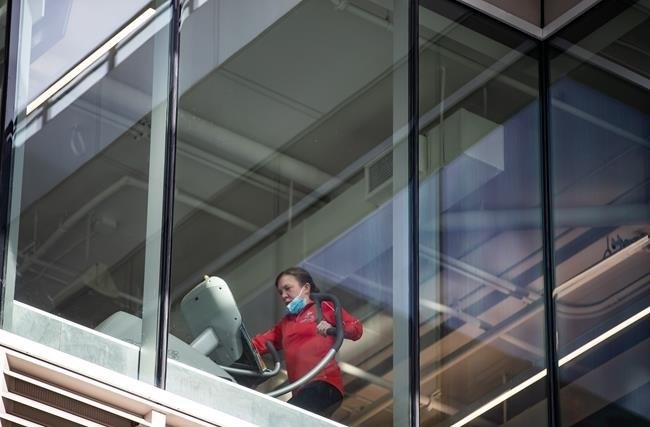
A woman wears a face mask on her chin while exercising at a fitness centre and gym, in North Vancouver, B.C., on Wednesday, January 6, 2021.
Image Credit: THE CANADIAN PRESS/Darryl Dyck
February 26, 2021 - 5:30 AM
MONTREAL - With spring just around the corner, people will soon be able to return to outdoor workouts, and with government restrictions beginning to lift in some provinces, they might even be able to go back to their usual gym routines.
But for those who prefer guided workouts or aren’t ready to face the health risks of visiting a gym, there are ways to get many of the same benefits while keeping a tight budget.
Throughout the pandemic, options for at-home workouts and other solo fitness offerings have proliferated. They include free, pre-recorded home workouts that require limited or no equipment, exercise bike rental programs at gyms and spin studios, and even private workout space available for rent.
In many cases, these offerings are cheaper and provide more variety for your money than a traditional gym membership.
Econofitness, for example, a major gym chain in Quebec, offers free at-home workout videos on its YouTube channel, many of which require no equipment. For people with paid memberships, which range from $10 to $34 a month, it also offers varying tiers of specialized programming, from pre-recorded workouts to live classes held over Zoom.
“With the YouTube channel, you get very good at-home workouts,” said Renaud Beaudry, vice president of development for Econofitness. “It’s good to start if you’ve never worked out in a gym before.”
Some online platforms cater to people with more experience with workout classes. Amanda Zweig, a Montreal-based personal trainer and spin instructor, co-founded a platform called FitFomo with other local trainers, selling pre-recorded workouts for $29.99 a month.
The platform now regularly publishes content from five trainers and covers a variety of workouts, Zweig said, including videos for Pilates, barre, high-intensity interval training and strength training, which are uploaded twice a week.
For people who are wondering how to choose from the many fitness platforms that are out there, Zweig recommended sampling different ones. Other subscription-based online workout platforms include YYoga at Home, by the Vancouver-based yoga chain YYoga, and virtual classes from R Studios, which has locations in Halifax and Dartmouth, N.S.
“The best thing to do is to try out the free trial,” Zweig said, noting that most platforms offer customers the option of testing the service for one or two weeks. “You have to just try and see what works.”
Lyndsay Schneidman, who subscribed to FitFomo after having worked with Zweig and another trainer on the platform before the pandemic, said she appreciated being able to do the workouts on her own schedule. She had sampled other platforms but liked having the variety of different classes from multiple trainers on FitFomo, she said.
Some classes may require more equipment than others. Still, Zweig said that for under $100, people can purchase two sets of weights — one lighter, between one and five pounds, and the other between five and thirty — as well as a set of resistance bands, which should offer enough equipment for a variety of home strength workouts.
Many gyms and spin studios have also been renting out cardio equipment on a monthly basis throughout the pandemic, for people who are looking for flexibility. The gym at Concordia University in Montreal, for example, had been offering spin bike rentals for $45 per month, its website says, but the program is currently sold out.
For more equipment-intensive workouts, Silofit, a Montreal-based startup, offers its customers the ability to rent out a small gym space, fully stocked with weights and cardio equipment, where people can work out in private.
Before the pandemic, the app was mostly used by trainers looking for space to work with clients, but now, around half of the people making bookings are just looking for a place to work out, said Wilfred Valenta, the company’s CEO and co-founder.
Gym spaces range from 500 to 1,000 square feet and cost between $20 and $45 per hour, depending on the size of the space. Each of them is professionally cleaned in between sessions, Valenta said. The company will have 12 locations in Toronto and three in Montreal by the end of March, Valenta added.
Even once lockdown restrictions are completely lifted, Valenta sees fitness continuing in what he called a hybrid model. That model consists of people doing some workouts at home and only going to gyms for specialized classes, personal training sessions, or workouts that require additional equipment.
Schneidman said she is unlikely to buy another gym membership after the pandemic, saying that she was happy with her home workouts. Still, she may add in-person training sessions to her routine once it becomes an option, she said.
“I was someone before COVID that absolutely hated home workouts,” she said.
This report by The Canadian Press was first published Feb. 25, 2021.
News from © The Canadian Press, 2021